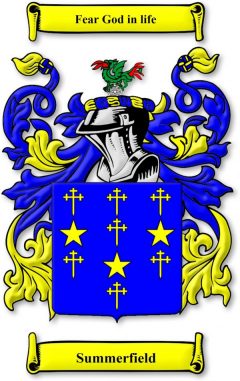My 12th Great Grandfather
UNKNOWN SOMERVYLE certainly existed because we have a little information on his sons from the Parish Records, but unfortunately nothing about himself.
They were all recorded as living in the ancient parish of Sandbach and given the birth dates of his children I would have to guess he would have been born about 1520, during the early reign of King Henry VIII. I could find no other information on this man and even the children I have attributed to him are largely done so by best fit as I found no evidence for their birth date either. The frequent name changes, both forename and surname, are not only from one generation to another but also within the same family and I am convinced are nothing more than the practice of keeping records in latin during the early years and recording errors. The church wardens or vicar, or whoever would have to write and spell a name from just the spoken word, which of course couldn’t be checked as few people were able to read or write at this time I haven’t been able to identify his wife, but the following children would have been born during the three year period in which Henry VIII married Anne of Cleves following negotiations by Thomas Cromwell, and then divorced her and married Catherine Howard. Thomas Cromwell was executed on charge of treason closely followed by Catherine Howard, so that Henry could marry Catherine Parr.
- JOHES SOMERVYLE born about 1543 in Sandbach, and died 28th August 1591 in Sandbach.
- RADI SOMERVYLE born about 1544 in Sandbach.
- WILLIMUS SENIOR SOMERVYLE born about 1545 in Sandbach, and died there 11th December 1610.
SANDBACH, by 1872 it was a town, a township, a parish, and a sub-district, in Cheshire. The town stands near the river Wheelock, the Grand Trunk canal, and the North-Western railway, 4. miles north east of Crewe. The town was formerly famous for malt liquor, and for worsted-yarn and stuffs; and by 1857 was carrying on silkthrowsting in several extensive factories, the making of boots and shoes for the Manchester and Liverpool markets, and a considerable trade in connection with salt-works and corn mills. Population in 1851, 659; in 1861, 989, living in 1082 houses. The Old Hall was built in 1656 and formed a fine specimen of old timber-framed houses, it subsequently became an inn. The parish also contains the townships of Arclid, Bradwall, Wheelock, Betchton, Hassall, Blackden, Twemlow, Cranage, Leese, Cotton, Church-Hulme, and Goostrey-with-Barnshaw; the last in Northwich district, all the others in Congleton district. Many of which feature in the lives of the people we will be learning about in these pages.
This map and township description and others that follow is based on data provided through www.VisionofBritain.org.uk and uses historical material which is copyright of the Great Britain Historical GIS Project and the University of Portsmouth.
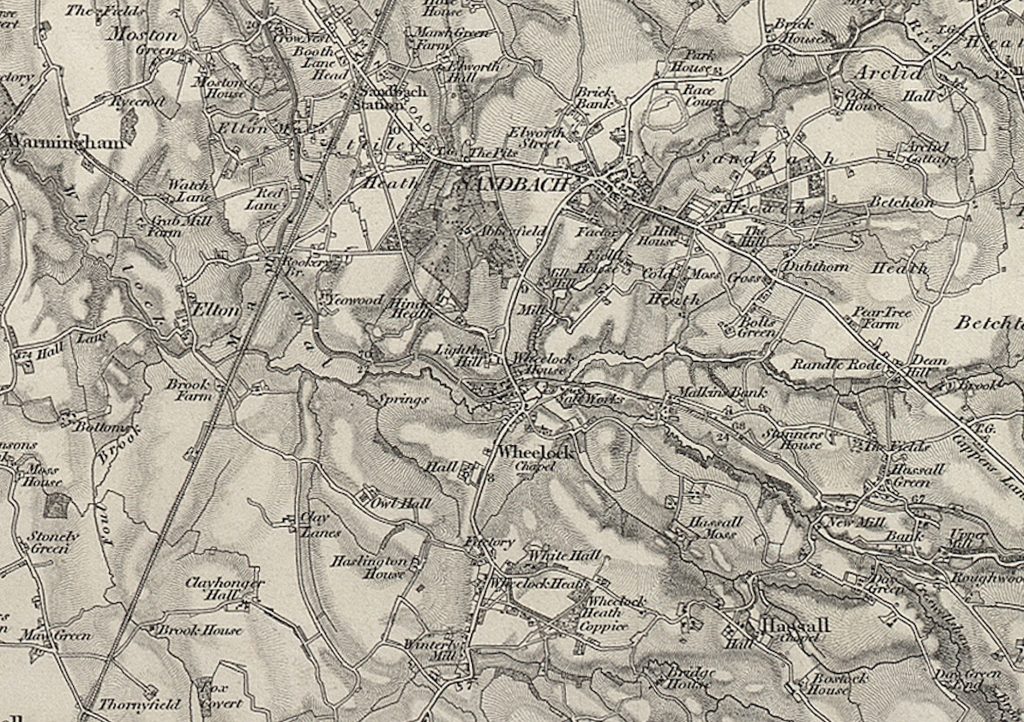
I could find little information on his younger brother Radi, other than that he had married Elizabetha Milnes on 24th April 1564 in Sandbach, and no children have been discovered. But we do have a bit more on Willimus Senior. His first marriage was to Alienora Bixwicke on 11th August 1566 in Sandbach when he would have been 21 years. Son Willimus Junior was born three months later on 25th November. However their next child, Isabella, was not born until 5th May 1572, closely followed by another girl, Alienora, in 1573. We don’t have her date of birth but she died a baby on 15th August. The fact that the mother also died in the same August, on the 31st, does suggest that perhaps there had been complications with the birth or perhaps affected by one of the many diseases that blighted these areas in the 16th century. But our Willimus didn’t hang around, he married his second wife, Margeria Lea, just over two months later on the 12th November. Together they had another three children, Radus born in April 1575 but died in October, Ellena in 1579 and Margeria in 1584. Margeria the wife of Willimus Senior died in 1594 but he lived on until 1610. He was 65 years at his death. There was obviously some wealth in the family, indicated in the wills of Johes himself in 1591 and also Willimus the son of his brother, Willimus Senior, in 1637, more of which below.
My 11th Great Grandfather
JOHES SOMERVYLE would have been born about 1543, I have his burial recorded as 28th August 1591 in Sandbach, which is also confirmed by his Last Will and Testament.
While Sir Francis Drake was sailing the Golden Hind and becoming the first Englishman to circumnavigate the globe, Johes and with his wife Cicelia he had the following children.
- JOHES SENIOR SOMERVYLE born 16th December 1570 in Sandbach, Cheshire, died 20th September 1609 in Sandbach.
- HUGOIS SOMERVYLE born 26th September 1565 in Sandbach and died in Wheelock, 3rd May 1598.
- THOMAE SOMERVYLE born about 1564 in Sandbach, and died 6th July 1633 in the same place.
- ELLENA SOMERVYLE born 6th May 1568 in Sandbach.
- CICELIA SOMERVYLE born about 1569 in Sandbach.
- MARIA SOMERVYLE born 8th July 1575 in Sandbach.
The death of Johes Somervyle (1543 – 1591) must have been unexpected because his will I believe was written jointly by his son Johes Senior and Johes’s brother Willimus Senior (1545 – 1610), presumably when he was more or less on his deathbed as you can see from the text of his will. Thomae was about 27 at the time of his fathers death and was not to marry Ellena Shawe for another two months, Hugois was 26 and had married Ellena Alger of Barthomley in 1588. Daughter Ellena was still single marrying Giorgious Wright in 1593 and Cicelia had already wed Rogerus Furnevall in the April of 1591. Maria at 16 was still single as was Johes himself at 21 . I have wondered why he made Johes one of the witnesses when both Hugois and Thomae were older, most likely because of Primogeniture Thomae was the legal heir as the eldest son. Primogeniture is the right, by law or custom, of the firstborn legitimate son to inherit his parent’s entire or main estate in preference to shared inheritance among all or some children, any illegitimate child or any collateral relative. In addition Hugois was already established with his wife. Johes, Ellena and Maria were all still dependents so it made sense for them to be the beneficiaries. In the will he describes that all of his goods should be shared equally between Johes and his two sisters Ellena and Maria, with the exception of one cart and plough with its gear to be given to his eldest son Thomae. Debts that were owed to him were largely balanced out by debts that he owed others, which left a small estate shared between the four children.
Although only a minority of our ancestors left wills, they can provide valuable details about a person’s social status and family relationships. Wills vary considerably in both size and content, from virtually no detail to the extremely detailed (sometimes enabling you to construct a family tree of several generations). Up until the 1750s inventories listing the deceased’s property were often attached to the will, giving details of household goods and the tools of his or her trade. When someone died without leaving a valid will, letters of administration (or ‘admons’) could be granted to the person’s next of kin.
This below is a transcript of the will of Johes Somervyle (1543 – 1591) that I have had transcribed, as the original is a combination of legal jargon, largely illegible handwriting and some of it written in Latin. Original capitalisation and spelling have been retained. Letters added to expand abbreviations are in square brackets [ ]. Interlined letters (those written above the main line of writing) are included in angled brackets < >. Punctuation and paragraphs have been added for ease of reading.
The nuncupative will of John Somervile of Sandbach, made 27 August 1591
In the name of god Amen m[emoran]d[um] that the xxvijth of August Anno D[omi]ni 1591 John Somervile of the p[ar]ish of Sanbage decesed being visited w[i]th sicknes yet of good and p[er]fect memorye did declare and p[ro]nounce his last will and testament w[i]thout writing in the p[re]sence of Willia[m] Som[er]vile, John Som[er]vile [and] others in mann[er] [and] forme hereafter ensueing, viz. he willed and desired that all his Debtes shold be first paide and discharged of all his whole goodes and then the Remaynder thereof except on Cart on ploughe and all Cart geare w[hi]ch he gave to Thomas Som[er]vile his eldest sonne to be devided into three p[ar]tes whereof he gave on p[ar]te to John Som[er]vile his sonne and the other ij p[ar]tes to Ellene Somervile and Marie Somervile his ij Daughters. Wittness[e]s as abovesaid Willia[m] Some[r]vile John Som[er]vile w[it]h others
Thomae, married twice, first to Ellena Shawe (1576 – 1599) in 1591 and again, somewhat confusingly for historians to another Ellena Shawe (1578 – 1636) in 1600. They were likely from the same family group although they had different fathers, Wmi and Rici. I stumbled across an interesting document in my search for more background information on Thomae, which I have included below, because it identifies him and for the first time a member of the family described as a Gentleman, which was well up the medieval pecking order.
The Inquisition post mortem of Phillip Oldfield who died at Chester 15th December 1616, aged 75. Inq. taken at Sandbach, on the 13th June [15 year of James] 1617 before Henry Maynwaringe, Escheator, Ralph Wilbraham, feodary, and William Leversegge, by virtue of a writ of enquiry after the death of Philip Oldfield, late of Bradwall, deceased, by the oath of Humphrey Page of Yardshawe gent Richard Steele of Sandbach gent, John Rode of Walhill gent, Thomas Hodgkinson of Smalwood gent, Reginald Finlowe of Holme Walfield gent, John Wereham of Lawton gent, William Venables of Sproston gent, John Kinsey of Wimbaldesley gent, Hugh Furnivall of Betchton gent, Thomas Somervile of the same gent, John Shawe gent, Richard Kettle of … . gent, William Shawe gent and Hugh Broome gent, who say that Philip Oldfield of Bradwall was seised in his demesne as of fee, viz to himself and his heirs by Helen his wife deceased of and in 10 messuages, 100 acres of land, 40 acres of meadow, 200 acres of pasture, 50 acres of wood with their appurtenances in Bradwall and also of one other messuage in Bradwall in the occupation of Eleanor Minshull and all the lands and tenements to the same belonging. And of and in 10 acres of land, 10 acres of meadow 10 acres of pasture with their appurtenances in Sproston. And of and in 8 messuages, 5 gardens, 10 acres of land, 5 acres of meadow and 10 acres of pasture in Middlewich and Newton near Middlewich, purchased by the said Philip Oldfield from Sir Thomas Egerton knt and John Egerton esq.
- Inquisition post mortem Inquisitions post mortem were local inquiries into valuable properties, in order to discover what income and rights were due to the crown and who the heir should be. These inquiries took place when people were known or believed to have held lands of the crown, and therefore involved individuals of considerable wealth and status. Under the feudal system all land belonged to the monarch and was therefore either held by him directly (the royal demesne) or on his behalf, directly or indirectly.
- Writ of enquiry These were inquiries, undertaken after the death of a feudal tenant in chief (that is, a direct tenant of the crown), to establish what lands were held and who should succeed to them.
- Escheator The name of an officer who was appointed in every county to look after the escheats which fell due to the king in that particular county, and to certify the same into the exchequer.
- Seized in his demesne as of fee This is the strict technical expression used to describe the ownership in “an estate in fee-simple in possession in a corporeal hereditament.” The word “seised” is used to express the “seisin” or owner’s possession of a freehold property: the phrase “in de mesne,” or “in his demesne,” (in dominico suo) signifies that he is seised as owner of the land itself, add not merely of the seigniory or services; and the concluding words, “as of fee,” import that he is seised of an estate of inheritance In fee-simple.
It also describes Thomae as living in Betchton, a township cropping up time and again in the history of the family. I was also interested to note how interconnected these worthy Cheshire families were. For example, in the 1591 will for Johes he died having debts to amongst others, Mr Liversage, same man or father of the William Leversegge in the inquiry above. Also Karen Frinifull, being owed a massive £16 13 shilling and 6 pence, and Roger Frenifull owed £5 10 shilling, both probably derivatives of the Furnivall name often mentioned. Including Rogerus marriage to Johes daughter Cicelia just before he died. A Hughe Furnivall was also one of the appraisers of the will. As was William Shawe also described in the enquiry as a Gentleman, as was Richard Shawe who also appears in the will owing Johes at his death £16 13 shilling and 4 pence (strangely close to the amount Katern Frinifull was owed). Not forgetting of course Thomae, above and more below, who managed to marry two of Ellena Shawe one daughter each from the Richard and William above.
Thomae died intestate on 6th July 1633 in Sandbach with an inventory of his assets made on the 10th. The appraisors being his nephew John Somerfild (1600 – 1652), the eldest son of his brother John (1570 – 1609), son in laws John Dalle, who was married to Anna ( – 1598) from his first marriage and Thomas Shawe who was married to Margeria (1615 – 1637) from his second, and George Twemlow, with the total amounting to some £136, possibly hundreds of thousands of pounds as wealth today. On 2nd May 1636 his surviving wife Ellen also made a will, dying before the end of that year. That inventory of goods came to nearly £100 so with leased land, property and other earnings it was still a substantial estate. She did I think make a non too subtle point in relation to the first wife, as the two surviving children received 12 pence each, whilst the children born to her shared the not inconsiderable remainder. Hugois married Ellena Alger 3rd June 1588 in Barthomley but later settled in Wheelock just a few miles south of Sandbach where he was living when he died in 1598 at just 33 years, leaving three children under 10 years, Ellinore born in 1591, Jana born in 1595 and son Rauphe. His will which was proved in 1598 showed him having accumulated considerable wealth, with brother Thomae named as the Executor. I have puzzled as to why he wasn’t mentioned in his fathers will in 1591, but I now think that when he married in 1588 his wife Ellena came with a substantial dowry that maybe meant he didn’t need the legacy. I think that these early farming generations of our family might well have been amongst the wealthiest in the area.
My 10th Great Grandfather
JOHES SENIOR SOMERVYLE born 6th December 1570 in Sandbach, Cheshire. He died 20th September 1609, in Sandbach.
Elizabeth I who has been on the throne since 1558 dies and is replaced by James I in 1603. In 1605 Guy Fawkes and other Roman Catholic conspirators fail with their infamous Gunpowder Plot in an attempt to blow up him and his Parliament.
With his wife Margeria Strongthearm of Goostrey, whom he married around 1600, Johes Senior had three children that I have been able to identify:
- JOHIS JUNIOR SOMERVYLE born 2nd December 1600 in Brereton cum Smethwick and who died on 4th September 1652 in Sandbach.
- ELIZABETHA SOMERVYLE born 18th November 1602 in Brereton cum Smethwick.
- THOMAS SOMERVYLE born 2nd December 1607 in Brereton cum Smethwick.
BRERETON CUM SMETHWICK, St Oswald, Cheshire is an Ancient parish including Smethwick, it was a township in the ancient parish of Brereton in the Northwich hundred, which became a civil parish in 1866. It was situated on the river Croke, 2 miles south east of Holmes-Chapel railway station, and 3 miles north east of Sandbach. There was a chapel at Brereton from the reign of Richard I (1189-99). Canon Sladden in ‘Beside the Bright Stream’ relates that Sir William Brereton built a church at Brereton in about 1200, it was dedicated to St. Oswald of Northumberland. Brereton was originally in the parish of Astbury, Cheshire and became a parish in its own right in the reign of Henry VIII (1509-47). The church registers begin in 1538. The list of ministers goes back to Gilbert de Brereton in 1297. Brereton Hall was built by Sir W. Brereton, the parliamentary leader; and in 1872 was the seat of the Howards. Brereton cum Smethwick civil parish was abolished in 1936, and incorporated into Brereton. It included the hamlets of Bagmere, Brindley Green, Brownedge, Hazelshawe, Illidge Green, Medhurst Green, Sandlow Green and Smethwick. It had a population of 556 in 1801, 649 in 1851, 552 in 1901, and 613 in 1951.
Johes Senior was 21 when his father died, and their mother Cicelia had already been dead for seven years so it’s likely that the family was used to pulling together to get through. Whatever the reasons might have been, Johes was 30 before he married Margeria in 1600. But life can indeed be cruel, whereas his father had been 47 before his early demise, Johes Senior died at just 39 in 1609, leaving three children of just two, seven and nine years. We know that although he and his forebears were all born and lived in Sandbach and Betchton, Johes Senior had set up the marital home in Brereton cum Smethwick, just a few miles away. I can find no information on what happened to Margeria and the children after the death of Johes. I could find no trace of a will. What we do know is that the children of those youngsters were born and mostly lived in and around Sandbach, so I think it is likely that Margeria was taken in by the family and probably by Johes brother Thomas who lived in Betchton. Johes Senior had been left a legacy in his father’s will so they would have been reasonably financially stable. I think Elizabetha might have married John Buckley in Astbury 3rd October 1627. I couldn’t find a marriage for Thomas but he had three children I have been able to identify, Thomas born 17th January 1633, Johes 24th September 1636 and Anna 24th May 1643, all in Sandbach.
My 9th Great Grandfather
JOHIS JUNIOR SOMERVYLE born 2nd December 1600 in Brereton cum Smethwick and who died on 4th September 1652 in Sandbach.
I couldn’t find his wife but while they were having these seven children, there was a lot going on in the world. The Pilgrims landed at Plymouth Rock on Cape Cod, Massachusetts, in the “Mayflower” and founded New Plymouth. Charles I became King of England (to 1649) and married Henrietta Maria, sister of Louis XIII of France and then dissolved Parliament which failed to vote him money, but shortly after he was forced to accept Parliament’s statement of civil rights in return for finances. But then defiantly dissolves Parliament and rules personally until 1640.
- JOHES SOMERFYLE born 9th May 1622 in Sandbach, and died 16th March 1657 in Sandbach.
- THOMAS SOMERFYLE born 28th January 1623 in Sandbach.
- ELIZABETHA SOMERFYLE born 12th March 1625 in Sandbach, and died there in June 1662.
- HUGO SOMERFYLE born 4th June 1626 in Bradwall, Cheshire and died 19th March 1692 in Sandbach.
- RANUS SOMERFYLE born 25th March 1628 in Sandbach.
- MARIA SOMERFYLE born 8th April 1630 in Sandbach, and died there in 23rd May 1652.
- PETRUS SENIOR SOMERFYLE born 25th March 1632 in Sandbach, and died 3rd November 1707.
Johes married Margeria Strongethearme of Goostrey around 1640, you might have noted that we already have had a marriage between Johes Somervyle and Margeria Strongethearme, which had taken place about 40 years earlier. The coincidence of same names and birthplace I am sure means they were both from the same family group but I wasn’t able to confirm it. It did create quite a bit of confusion in the early stages of research trying to match up children and relatives from what was actually a different generation of the family. Johes and Margeria had four children Willimus born on 30th July 1642, Elisabeth born on 13th February 1652, Anne born 20th October 1654 and Johes born 6th May 1656. He was just 30 when his father Johis Junior died and he presumably inherited the bulk of his father’s estate, although there seems to be no will to confirm this. But when Johes himself dies in 1657 and just 35 years old his will confirms that he is for certain the current resident of the Crosse Estate. The Crosse Estate or Farm or just The Crosse, comes up many times during the three hundred year period that I have researched the family in Cheshire. There are some interesting stories around The Crosse which might be confusing to introduce at this point as its not in the direct ancestral line, so I will continue with tracing that for now and perhaps come back to these other stories before we leave Cheshire for Lancashire at the turn of the 19th century. I didn’t find a wife for Thomas, but I found three children. Thomas born 2nd February 1652 but died before he was two in 1653. John born 25th October 1656 and an unamed child born 29th May 1658 but died the same day, all in Sandbach. Elizabetha died at just 37 years apparently without having ever married. Hugo however married twice, first to Amelia around 1647 with whom he had five children, all girls, Sarah, Elizabetha, Joanna, Eleonora and Sarah. The first two of which are known to have died in infancy. Amelia herself died in April 1665 and Hugo married his second wife Jana Ellis in October 1666. Ranus, or as he is sometimes recorded Ranulphus, didn’t get married until 1662 when he would have been 34. That may have been because his older brothers had all married before their father died in 1652 and Ranulphus had some responsibility for running the estate. He married Maria Piggot and they had five children, Maria in 1663, Johannes born in 1665 but died the same day, Sarah born in 1666, a second Johannes born in 1669 and Josephus born in 1671. Maria died at just 22 years and was unmarried.
It is perhaps worth mentioning here an explanation of the agricultural roles our ancestors played. Almost without exception, up until about 1800 our family has been involved in farming at one level or another. You will see Labourer mentioned, this would also be described as Farm Labourer or Agricultural Labourer. The Agricultural Laborer was paid day wages, hired on a short term as and when work was needed. He or she was given no accomodation, often operated as part of a gang under a contractor, and received only wages. The Farm Servant was just a little further up in the pecking order. Maybe quite a lot further if you were at the bottom! If single, he ‘lived-in’ and bed and board were part of the contract for hire, and if married, he was provided with a house or a cottage, with possibly some grazing rights or strip of land to use and some provisions for the family. Next level up was a Husbandsman, which was a free tenant farmer or small landowner. The social status of a husbandman was below that of a yeoman. The meaning of ‘husband’ in this term is ‘master of house’ rather than ‘married man.’ A Yeoman is a person who owns and cultivates a small farm, someone belonging to a class of English freeholders below the gentry, a man who was not a servant and who owned and grew crops on an area of land. In medieval England and well into the 18th century Yeoman was used to describe land owners considered only one step down from the gentry classes. They would have been free men living in large country farmhouses and employing many indoor/outdoor servants. A Gentleman a was a man of the lowest rank of the English gentry, standing below an esquire and above a yeoman, who has a farm as part of his estate and who farms mainly for pleasure rather than for profit.
My 8th Great Grandfather
PETRUS SENIOR SOMERFYLE born 25th March 1632 in Sandbach, and died 3rd November 1707.
Petrus was born in the same year that building work started on the Taj Mahal in Agra, India. With an unidentified wife he had two children.
- RANULPHUS SOMERFIELD born 7th September 1661 in Bradwall, and died 7th November 1704 in Lower Withington.
- PETER JUNIOR SOMERFIELD born 28th April 1664 in Bradwall and died 21st April 1725 in Alsager.
Bradwall is a small village and civil parish in the unitary authority of Cheshire East, about 2 miles North West of Sandbach in the ceremonial county of Cheshire, and about 20 miles south of Manchester. According to the 2011 census, the population of the entire parish was 182. The area is predominantly agricultural, with no manufacturing or retail outlets. The village is not mentioned in the 11th-century Domesday survey, but from the 13th century gained notability as the manorial estate of Richard de Bradwall and his successors, including the families of Venables, Berington and Oldfield. From the early 19th century, it became the seat of the Latham family of Bradwall who resided at Bradwall Hall until its demolition in the early 20th century.
Again I have had difficulty finding a marriage for Petrus Senior but it must have been around 1660/61 when his son Ranulphus was born. The only other child I have found for Petrus is Peter Junior. I think that Petrus would have been a farmer, or worked a farm. His residence recorded in the parish register for his death is Marsh Green, Bradwall. All there seems to be there is a farm called Marsh Green Farm, which would also account for special reference being made to it in the parish register, most other references are just the town, village or hamlet name. The image below I have found is of Marsh Green Farm, Elworth around 1910 to 1919, this is 250 years later and unlikely to be the same building, but probably on the same site.
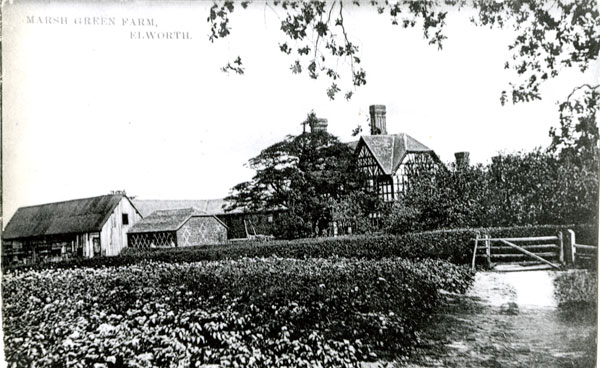
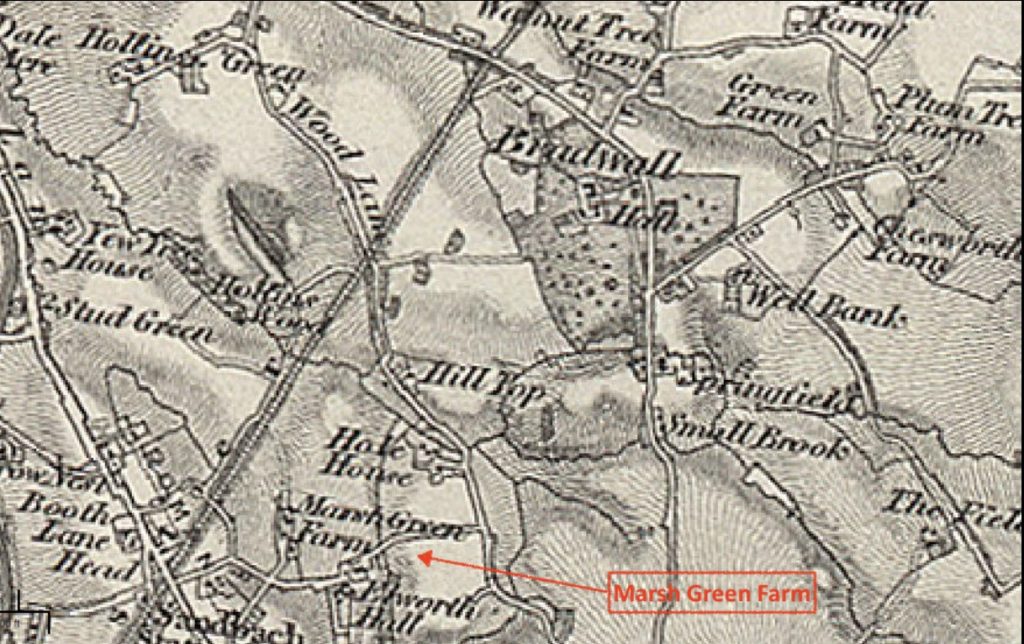
The image below is an extract from the Parish Register recording the death of Petrus or Peter Summerfield Senior of Bradwall. You will see that just a few days after Peter died there is a Catherine who died aged 87 years, it might have been his wife, although that would have made her in her early forties when the two children were born, its possible and could be a reason why there was only two children, or it could have been the wife of one of his brothers. Johes and Thomas were of a similar age to Catherine. I am uncertain of the reason for the cross or plus sign against some of the entries in the parish register, including Peter and Catherine, it might signify perhaps that a headstone was used in the burial. I didn’t find anything for a Peter in my recent brief trip but will spend more time looking when I go back.

Petrus Senior was the youngest child born in 1632 and only 20 when his father died in 1652. As we have noted already Johes as the eldest brother probably inherited the bulk of the estate but he was to pass away himself after only five years leaving the estate largely to his wife Margeria to look after his family who were all under 15 years. Petrus Senior just 25 himself at that time was an executor. My best guess would be that the whole family rallied around to run the estate, all the family members had Sandbach as their residency as well as resting place. Johes son John born in 1656 a year before his father died, probably assumed estate owner on reaching his 21st birthday in 1677. Petrus died in 1707 without a will, but that can be explained away by the fact that his eldest son Ranulphus died before him in 1704 making it a straightforward estate transfer to the remaining son Peter Junior.
My 7th Great Grandfather
RANULPHUS SOMERFIELD born 7th September 1661 in Bradwall, and died 7th November 1705 in Lower Withington.
Ranulphus was born just a few years before the Great Fire of London swept through the central parts of the city from Sunday, 2nd September to Thursday, 6th September 1666. With his wife Elizabeth Low he had six children.
- SAMUEL SOMERFIELD born 1st October 1685 in Sandbach.
- PETER SOMERFIELD born 21st June 1689 in Sandbach.
- RANDLE JUNIOR SOMERFIELD born June 1691 in Sandbach.
- MARTHA SOMERFIELD born 21st July 1693 in Sandbach.
- JOHANNES SOMERFIELD born 1st October 1695 in Sandbach.
- HANNAH SOMERFIELD born 23rd January 1697 in Sandbach.
Ranulphus and Elizabeth married at Siddington in 1683 but they must have decided to live with his family because all of their children were born in Sandbach. However by the time of his death in 1704 he was living in Lower Withington which is very close to where he married Elizabeth in Siddington. His son Peter married Elizabeth Thorley also from Siddington and all of their children were born in and around the area. I think that the death of Ranulphus was relatively unexpected because he died intestate with his widow having to take the legal initiative as shown in the image below so as to manage his affairs. His eldest son Samuel after all was only 19. I think they might have relied quite heavily on Ranalphus brother Peter Junior who after marrying Martha Twemlow in 1697 was at the time living in Bradwall.
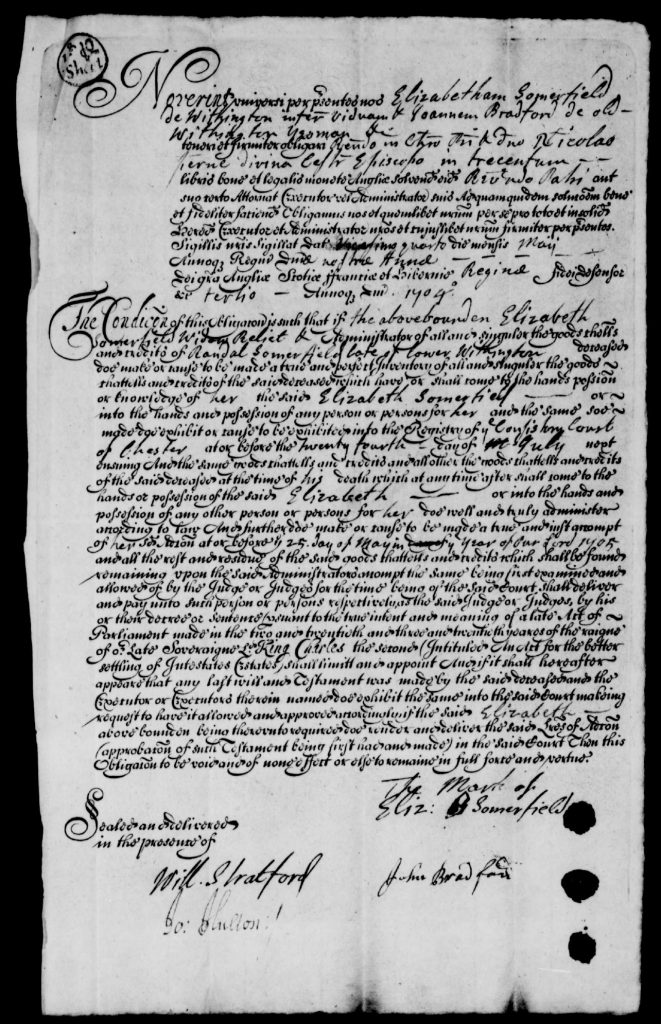
There is little to tell for eldest son Samuel, Peter we have already touched on, they had three boys and a girl. Amongst the boys were two butchers and a tailor. Randle Junior however has a bit more form. He married Mary Rathbone at Brereton cum Smethwick in 1714, a couple of months after their son George was born. They had five more children, Thomas 1715, John 1717, Peter 1718, Nathan 1721 and Mary 1723. But in 1725 there was also the twin boys, John and Richard, that were born to Sarah Slater out of wedlock. The Parish Register noted “Base born sons of Randle Jnr. Begotten on the body of Sarah Slater”. The twins unfortunately only lasted under a week. This cannot have been a good time for his wife Mary and she died at just 36 in 1729, perhaps of a broken heart, leaving a family ranging from 6 to 15 years old. There is no record of him marrying again, the usual course for a father left with a young family, and he lived a long life to his death in 1767. Not a wealthy man I would suggest as he died intestate with his assets determined at under £10 , his sons John of Alsager, Husbandsman and Nathan also of Alsager, Farmer, executors of his estate.
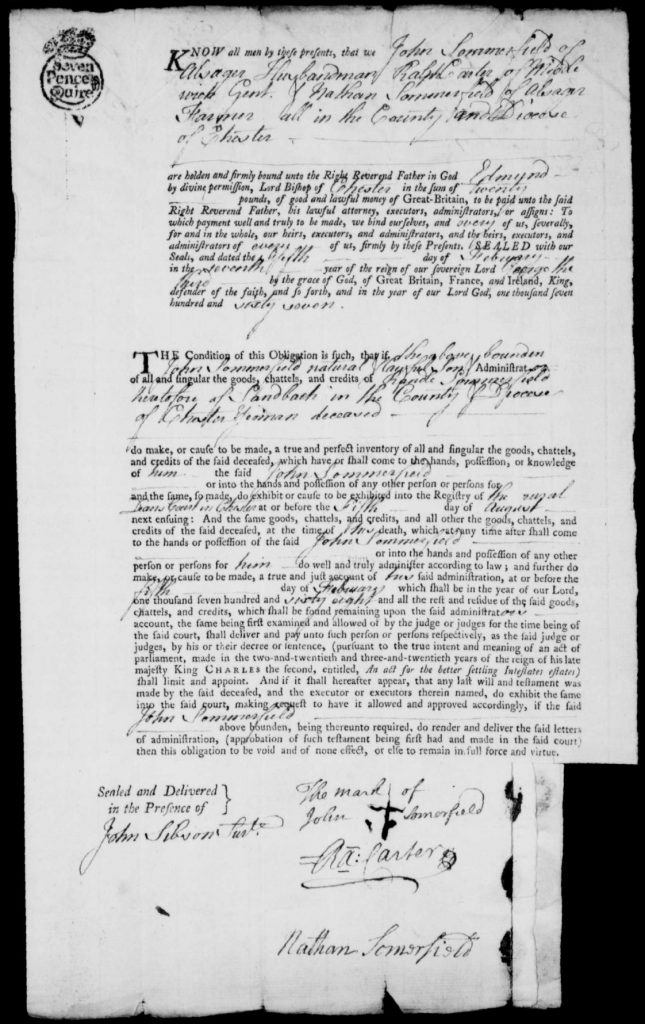
There is little to tell about Martha and Hannah other than the recording of their births. Johannes we will cover next.
My 6th Great Grandfather
JOHANNES SOMERFIELD born 1st October 1695 in Sandbach.
Johannes birth coincided with the death of Mary II, leaving William III to rule alone. Mary died at the age of 32 leaving no children. William had loved his wife deeply, despite the somewhat tempestuous nature of their relationship, and was grief-stricken at her death. England had accrued a considerable national debt on the back of William III’s expensive wars. Scottish merchant William Paterson founded the Bank of England to assist the Crown in managing its debt. The Bank became the national reserve, and in 1697 its position of prominence was secured when parliament forbade the formation of any further joint-stock banks in England. The bank has issued bank notes since 1694. A separate Bank of Scotland was established in 1695.
We know that Johannes was 10 when his father dies and 27 when his mother does. Her death is recorded as being in Betchton, if that was actually The Crosse at Betchton then maybe the Somerfield family there had taken her in, Ranulphus did share a grandfather with them. But I think more likely is that the family initially had been looked after by their uncle, Peter Junior, who had settled around Alsager, Barthomley and Weston. Johannes was 30 when he married Martha Pool in 1725 at Saint James, Audley, Stafford, but must have settled back in his home turf because all of his children were born in the Alsager, Barthomley area. With his wife Martha they had five children.
- PETER SOMERFIELD born 11th October 1727 in Alsager.
- JOHN SOMERFIELD born 27th February 1728 in Alsager but who died the same year.
- JOHN SOMERFIELD born 20th December 1730 in Barthomley.
- WILLIAM SOMERFIELD born 24th March 1731 in Barthomley but who died in 1733.
- ELIZABETH SOMERFIELD born 21st August 1733 in Barthomley.
Peter born 1727 is the man we want to follow, but let me first just mention his siblings for completeness. The first John born in 1728 sadly only lasted a few weeks, as we know child mortality was high in those times, but the second John born in 1730 I think fared better. His father was described in the Barthomley Parish Register as a Husbandsman of Alsager at his son Johns baptism. William unfortunately also died young, born in 1731 and died in 1733. Elizabeth born in 1733 I think I have found marrying Samuel Parker in 1754 at Witton cum Twambrookes.
My 5th Great Grandfather
PETER SOMERFIELD born 11th October 1727 in Alsager and died 21st January 1802 in Brereton cum Smethwick.
Peter was born in the same year war broke out between Spain and Britain, resulting in the siege of Gibraltar by the Spanish. In the same year the Quakers raised for the first time the subject of the abolition of slavery in the colonies. He married his first wife Ann Walton in 1757 in his final resting place Brereton cum Smethwick and died there in 1798. He then married Mary Hall of the same township in 1799 until his death in 1802, Mary lasting a few years more until 1808. Peter and Ann had nine children together, all born in Brereton cum Smethwick.
- MARY SOMERFIELD born 19th August 1757.
- SARAH SOMERFIELD born in 1760.
- JOHN SOMERFIELD born 12th February 1762 and who died 1804 in Brereton.
- ANN SOMERFIELD born in 1765 and died in 1768.
- MARTHA SOMERFIELD born 1767 and died 1768.
- PETER SOMERFIELD born November 1768 and died in December.
- PETER SOMERFIELD born in 1771.
- HUGH SOMERFIELD born in 1775 and died in 1778.
- SAMUEL SOMERFIELD born in 1777.
Three children died young in 1768 and another 1778, all probably of smallpox which had outbreaks in Cheshire around that time. There is little else of note going on with the family, Mary and Samuel both married and had children and John we will get to next.
But before we do that I would like to share this piece of research I came across from the Swettenham Parish Register.
In modern rabies-free Britain we forget that the United Kingdom was once as prone to rabid animals as the rest of the world. Without over-stating the matter, rabies is one nasty virus: its rod-like bacteria invade the central nervous system through a bite from an infected mammal (dog, person it’s all the same). A feeling of euphoria descends and the sufferer feels great, and certain they didn’t get infected. There’s a variable incubation period before the paranoia and insomnia begin. Gradually, the anxiety will become delerium and the sufferer will begin to salivate, and their eyes will run, yet at the same time, they can’t swallow properly. They become frightened of drinking water because their throat is closing up, resulting in the famous hydrophobia, which was usually put down as the cause of death, even though it is always respiratory failure due to paralysis. Rabies was known and feared in London throughout the Georgian period, with notable outbreaks in the 1750s, beginning in St James’s in 1752 and reaching a peak in 1759, when rewards were offered for roaming dogs shot in the street, whether rabid or not. It prompted a cull of London’s strays that equalled the plague culls of the previous century.
Transcription from Swettenham Parish Register, November 22nd 1746.
A never failing recipe for the bite of a mad dog.
- 24 grains of Factitious Cinnabar
- 24 grains of Native Cinnabar
- 16 grams of the best musk
[The Factitious Cinnabar is composed of Quicksilver and Sulpher joined together; and the Native Cinnabar is the same ingredients joined by Nature in nearly the same proportions. Native Cinnibar is an Ore of Quicksilver, Factitious Cinnibar is an artificial Ore, Mercury reduced to this state by an artificial Mixture of Sulphur].
Pulverise them together, fine, and take it in a Tea-Cup full of Arrack. or, if not to be had, the same quantity of French Brandy. The Dose to be taken as soon as possible after the Bite, to be repeated 30 days by way of prevention and when the Symptoms of Madness appear, then the Dose to be given every 3 hours, and be proportioned to the age of the patient. The above being for a grown person
[Arrack, also spelt arak, is a distilled alcoholic drink typically produced in South Asia and Southeast Asia, made from either the fermented sap of coconut flowers, sugarcane, grain or fruit, depending upon the country of origin].
My 4th Great Grandfather
JOHN SUMMERFIELD born 12th February 1762 and died 1802 Brereton cum Smethwick.
During this time industrialisation of the Lancashire and Manchester mill towns saw Cheshire farms abandoned as workers sought a better living in the industrial towns, most likely the reason for our family tree to move from Cheshire to Lancashire in the early 1800’s with John’s son. However, industrialisation also bought benefits to Cheshire. The completion of the Trent and Mersey Canal in 1777 and innovations such as the Anderton Boat Lift, allowed Cheshire cheese and salt to become major county exports. Also the silk industry was developing in Macclesfield, triggered by Charles Roe building a watermill in Macclesfield in 1744. John married Martha Hancock at Brereton cum Smethwick in 1783, together they had four children all born in Brereton cum Smethwick.
- THOMAS SUMMERFIELD born 12th April 1786 and died 6th September 1853 in Sandbach.
- ANN SUMMERFIELD born 13th April 1788.
- MARTHA SUMMERFIELD born 2nd May 1790.
- JOHN SUMMERFIELD born 22nd October 1793.
Thomas was born in 1786 and Married Martha Booth in 1808 in Brereton cum Smethwick and their only child William was born in 1809. Interestingly his Great Grandson Thomas born in 1868 made a move around the turn of the century from Cheshire to the North East, Durham and Haverton Hill specifically. In the 1939 special census his son Ruick’s residence is Billingham and occupation is recorded as a Salt Boiler. This makes a lot of sense to me as salt making was a widespread industry in Cheshire and had been for centuries, and there was definitely a salt making business around Billingham and Greatham, where Saxa and afterwards Sharwoods had successful businesses. My mother worked at the Saxa Salt factory at Greatham in the years before she was married in 1933. Martha married John Hulse in 1812 at Brereton and they had two children.
My 3rd Great Grandfather.
JOHN SUMMERFIELD born 22nd October 1793 in Brereton cum Smethwick and died in Bradford Manchester 17th November 1876.
It is at this point of the story that we move to Lancashire, and it is the reason for that move that I would like to explore before we move on. John, the youngest child was just 11 years old when his father dies in 1804, Thomas the eldest was only 18. Johns paternal grandparents also of Brereton cum Smethwick had already died. Ann in 1798 and Peter in 1802. Peter’s second wife Mary died in 1808. So at the time of his fathers death John’s mother Martha had few options with Thomas the likely only breadwinner and herself and three other children to support as well as possibly a widowed mother in law Mary. Martha died in 1811 in Cotton near Church Hulme and I think that we can assume they had moved there from Brereton cum Smethwick. Martha’s mother had died in 1785 and likely her father had too by 1804, but its possible she had other family members she could call on. Whatever the reason, I believe it is around this time that John learned his future occupation in the blossoming silk and cotton mills around Congleton, perhaps even this one, Old Mill.
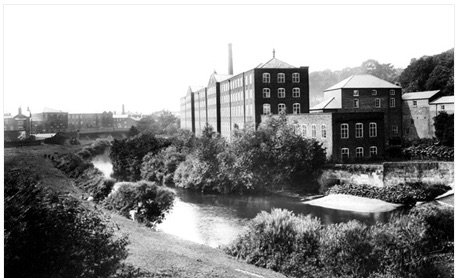
There were many textile mills built around Congleton for silk and cotton, powered by the water of the River Dane, and later by steam. Old Mill was built in 1753 and in this early photograph we see the twin pediments, the second added in 1830, also to the right is the Town Corn Mill. The Old Mill was an early silk mill, it used an internal water wheel to power the Italian Silk Throwing machines. It was notable for its size, and for the involvement of James Brindley in its construction. The mill was extended and a beam engine added around 1830, but it was partially demolished in 1939 and in 2003 the remaining structures were fully demolished.
It was the first silk mill in Congleton and was the largest and most conspicuous structure. Built of brick, with a pediment containing the dial plate of a clock in the centre. It was 240 feet long, 24 feet wide and 48 feet high, consisting of five storeys, and lighted by 390 windows. In 1771 it employed 600 people. In 1822 eleven circular throwing machines were housed on the ground floor with winding machines above. This was extended by another 17 bays in 1830. The Pearsons bought the mill from the Patinsons in 1830. In 1935 it suffered from subsidence, and Roldane Mill was built from some of the equipment. In 1939, the top three storeys were removed. It continued in use until 1996.
To learn more about my 3rd Great Grandfather John Summerfield and his family go to the section ‘Summerfield Families in Lancashire”. Or, continue here to learn a little about some of the family that weren’t in the direct line of ancestors.
Information recorded below is retained for a section about non direct ancestors not yet started and which I will come back to in due course.
JOHES SOMERFYLE born 9th May 1622 in Sandbach, and died 16th March 1657 in Sandbach.
- WILLIMUS SOMERFYLE was first born on 30th July 1642.
- ELIZABETH SOMERFYLE was born on 13th February 1652.
- ANNE SOMERFYLE was born 20th October 1654.
- JOHES SOMERFYLE was born 6th May 1656 in Betchton and died 31st May 1716 also in Betchton.
When Johes died Willimus would have been 15 but the other three children were all under five years. He had largely left his estate to wife Margeria but I suspect that the two executors Peter Senior and brother-in-law George Strongethearme would have a lot of involvement until Willimus became of age at 21, coincidentally the same year his mother died. Willimus himself didn’t marry until he was 31, marrying Ellena Deane in 1677. I have been unable to find any more information on this family group. Willimus as the eldest would or should have inherited the estate, but it is John who seems to have passed on the wealth. I wonder whether Willimus died at some point perhaps without children the estate passing on to the next eldest male. John didn’t leave a will so no clue there but his eldest son Johannes left one in 1752 which confirms the family still residing at the Crosse Farm.
It is through this particular family group that my Summerfield lineage is traced, through Johes the eldest child born 1622. He was just 30 when his father Johis Junior died and he presumably inherited the bulk of his father’s estate, although there seems to be no will to confirm this. But when Johes himself dies in 1657 and just 35 years old his will confirms that he is for certain the current resident of the Crosse Estate. The Crosse Estate or Farm or just The Crosse, comes up many times during the three hundred year period that I have researched the family in Cheshire. By the early nineteenth century it must have been a substantial estate as it crops up over and over again in tax records, tithes and even disputes such as this from the Sandbach Petty Sessions, reported in the Northwich Guardian 12th August 1865. This particular John Summerfield and resident of Cross Farm at that time would be my fourth cousin five times removed.
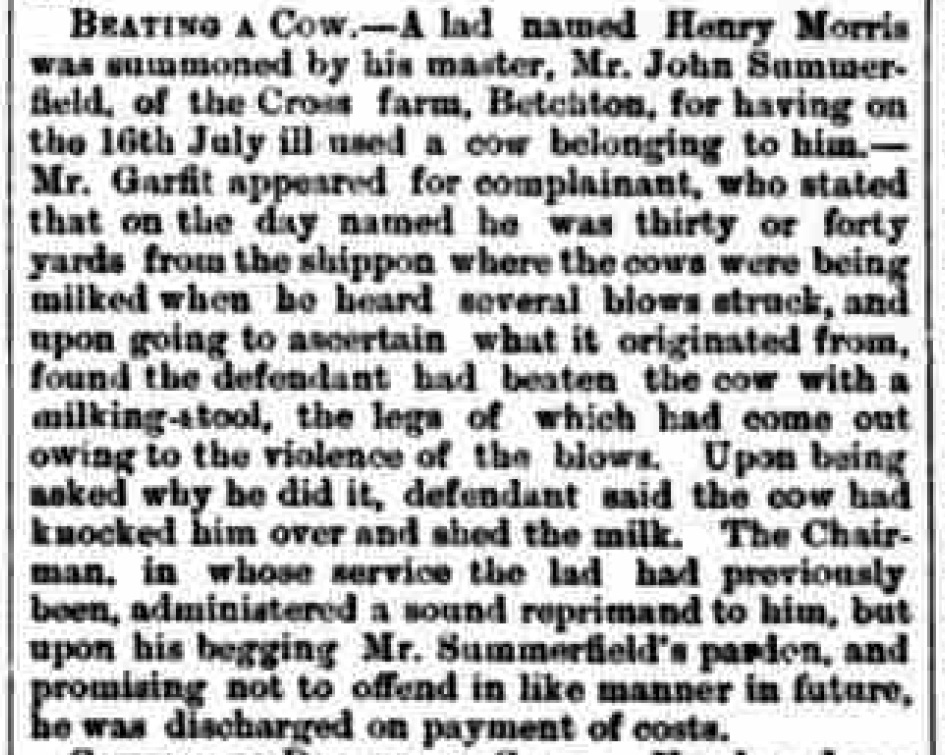
The first mention for the Cross Farm, although not by name, could be this one from the will of Willimus Somerfield Junior in 1637.
“and at the End of the said tearme my will [and] mynd is [and] I do heareby Devise give grant [and] assaigne ov[er] all the aforesaid Cottage messuadge land[es] [and] tenem[en]t w]i]th it[s] appurten[a]nc[es] Excepting [and] Reserveing unto John Som[er]fei[ld] of Betchto[n] that marled Craft w[hi]ch is in the possessio[n] of the aforesaid John Som[er]feild for and Duringe all the Rest [and] Residue of his Tearme”
A croft being a a very small farm around a house, or the house itself, and marled being a description as in marbled, and the John Somerfieild mentioned as the inheritor would be my 10th Great Grandfather Johes Junior Somervyle (1600 – 1652) who would have been his first cousin once removed. The Crosse is mentioned by name for the first time in 9th GGF Johes (1622 – 1657) will, which I have translated below.
In the will for Johes he describes himself as a Yeoman, but later on in time the description for the family head is often as Gentleman. This will was made on 15th February 1657. He died soon after on 16th March and was living at The Crosse in Betchton, he had outlived his father by just five years and again leaving young children to inherit his estate. His youngest brother and my 10th Great Uncle, Petrus Senior, who himself was only 25 years old was one of the executors, along with George Strongethearme the brother of Johes wife Margeria.
In the name of God Amen The fifteenth day of February And in the yeare of our Lord One thousand sixe hundred Fifty and seaven I John Somerfield of the Crosse in Betchton in the County of Chester yeoman, beinge infirme in body but of good and perfecte memory (thankes be to God therefore) doe make this my last will and Testam[en]t in writeinge as followeth. And first I Comend my soule into the handes of Almighty God my Creator nothinge doubtinge but that throughe the meritt[es] of the death and passion of my blessed saviour Jesus Christ all my sinnes are purged away, And my body I Comend to the earth to be buried in the Church or Churchyeard of Sandbach And for those worldly goodes Cattles and Chattles wherew[i]th God hath blessed mee I doe dispose of the same as followeth. And first whereas by One Indenture of Covenantes Confecte[d] and made at my mariage my <heire or> heires w[hi]ch shall enjoy my messuage or tenem[en]t after my decease are charged with the paym[en]t of One hundred and Twenty Powndes to be paid after such manner as I should dispose of the same by my last will and Testam[en]t or other writeinge under my hand and seale lawfully executed, I doe therefore accordinge to the purporte of the said Covenante in the said deed, and by this my last will and Testamente, give and bequeath the said sum[m]e of One hundred and Twenty Powndes to my children (exceptinge to my heire) to be equally and proportionably divided amongst them, And to be levyed and paid out of my said messuage at such tyme and in such manner as my Executor[es] hereafter menc[i]o[n]ed shall thinke meete and Conveniente. Also I give and bequeath to every of my Children Twelve pence apeece. Also All the reste of my goodes Cattles and Chattles (my debtes and funeral expences beinge first paid out of the same) I doe hereby give and bequeathe the same unto Margery my welbeloved wife towardes the bringinge uppe and education of my Children Also I doe constitute, ordaine and make my welbeloved brother in lawe George Strongetharme and my beloved brother Peter Somerfield my Executors to see this my last will and Testamente executed Accordinge to the trust I doe repose in them. And I doe hereby revoke [and] adnull all former or other will or wills by mee heretofore made and doe publish this to be my last will and Testament And in testimony heereof I have heereunto put my hand and seale the day and yeare above Written.
John Somerfeld Sealed and delivered and published to be my last will and Testament in p[re]sence of William Strongetharme his m[ar]ke S Shawe Thomas Shawe jn[r]
Indenture is a legal contract that reflects or covers a debt or purchase obligation. The term comes from the medieval English ‘indenture of retainer’ a legal contract written in duplicate on the same sheet, with the copies separated by cutting along a jagged (toothed, hence the term ‘indenture’) line so that the teeth of the two parts could later be refitted to confirm authenticity. Covenant is a promise in an indenture, or any other formal debt agreement, that certain activities will or will not be carried out. Also, up until the end of the 19th century brides from all spectrums of the propertied classes were expected to bring a dowry of some land or at least a sum of cash to their marriage. So, my reading of that paragraph in the will relating to an Identure of Covenantes Confected would be that a legal agreement was made at the time of Johes’s marriage to Margeria binding him to make that £120 payment out of his estate at the time of his death, before his other wishes would be executed, to protect to some degree the contribution her family had made when they were married.
John Somerfield born 6th May 1656 in Betchton, died 31st May 1716 also in Betchton.
John married Maria Furnivall 22nd October 1677 in Sandbach. Which if I have the correct birth date would have made her 31 years old at the marriage to his 21. But as their last child was born in 1685, making her 39, it feels like I probably have the right one. It is also likely given the disparity in ages that a substantial dowry would have been negotiated at the time of the marriage. There was quite a lot of Furnevall’s around in Sandbach so identifying the right one is a challenge. In the absence of his father and mother, both dead, the marriage was sealed by brother Willimus. John and Maria had four children.
- JOHANNES SOMERFIELD was born on 18th April 1679 and died 2nd February 1752.
- RANULPHUS SOMERFIELD was born on 22nd April 1681.
- THOMAS SOMERFIELD was born 30th June 1683.
- MARIA SOMERFIELD was born 23rd October 1685 all in Sandbach.
It is at this point in the story that my direct line of ancestors in the family tree diverts away from the bulk of the wealth, sad to say. My 7th GGF was Ranulphus, born in 1681, but as the eldest Johannes would inherit the estate from his father, probably with some fair accommodation for the rest of the family, but the family line through Johannes, b 1679, certainly all resided at The Crosse farm. Johannes married Ellen Smallwood on the 2nd February 1698 at Sandbach, he was 19 years old at the time which makes Ellen born in 1687 about 11 or 12, a little young by modern sensibilities. However their first child, Thomas, was born in 1708 and Ellen would have been 21 by that time. The last child, Ellen, was born in 1724 when her mother would have been 37 years and fitting a normal child bearing pattern.
Marriage was the only acceptable place for sex and as a result Christians were allowed to marry from puberty onwards, generally seen at the time as age 12 for women and 14 for men. Parental consent was not required. Although the church controlled – or tried to control – marriage, couples did not need to marry in a church. Legal records show people getting married on the road, down the pub, round at friends’ houses or even in bed. All that was required for a valid, binding marriage was the consent of the two people involved. In England some people did marry near churches to give greater spiritual weight to proceedings, often at the church door (leading to some rather fabulous church porches being added to earlier buildings), but this still did not necessarily involve a priest. Lord Hardwicke’s 1753 Marriage Act, made it illegal for those in England under the age of 21 to get married without the consent of their parents or guardians.
The following photos were taken of the gravestone in the churchyard of St Mary’s Church, Sandbach just outside the south walls of the church. It is lying flat on the ground and is broken into three parts. The information relates to John (Johannes born 1679) himself, his wife Ellen and also his granddaughter, Rebekha, the daughter of his son Thomas (1708 to 1791). Although obviously sick most of her life she outlasted her father as well as her grandfather. The contents are difficult to read but I think the gravestone details are as follows.
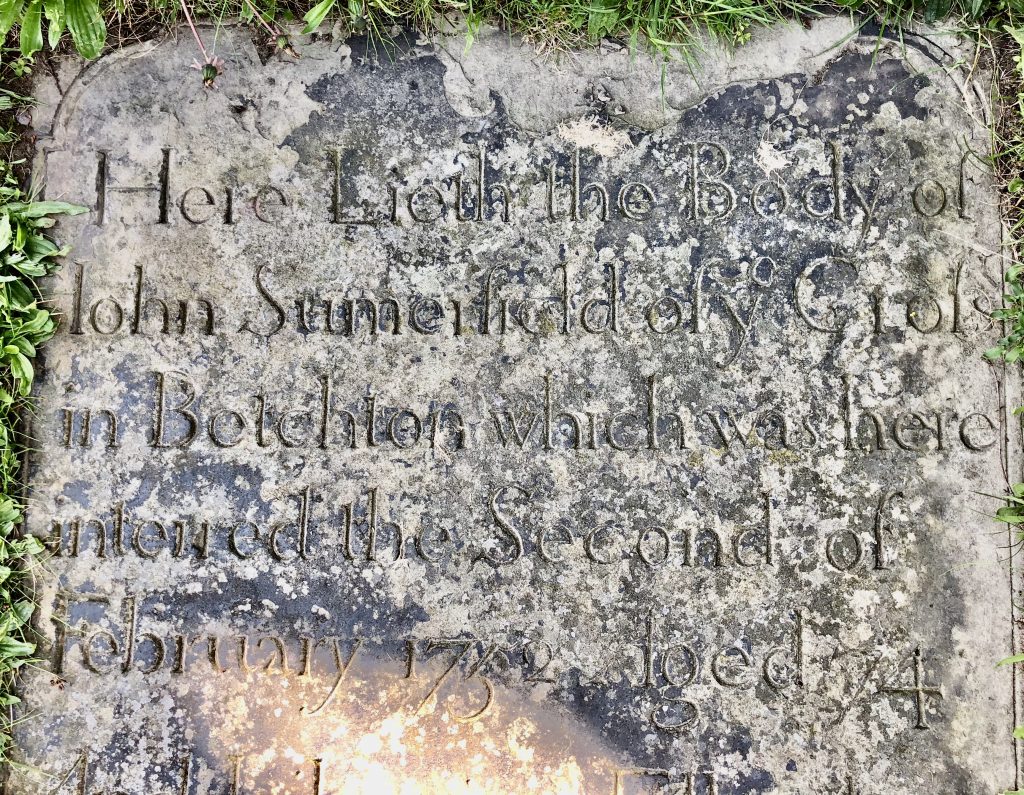
Here lieth the Body of John Summerfield of yo (short for Ye Olde I think) Cross John Summerfield of yo (short for Ye Olde I think) Cross in Betchton which was here interred the Second of February 1752 aged 74. And Likewise Ellen his wife was here interred 20th of September 1754 aged 67. Here resteth the Body of Rebekha Summerfield who after Bearing a long and painful illness with a truly Christian Fortitude and pious Resignation departed this Life October 1st 1796. Aged 55.
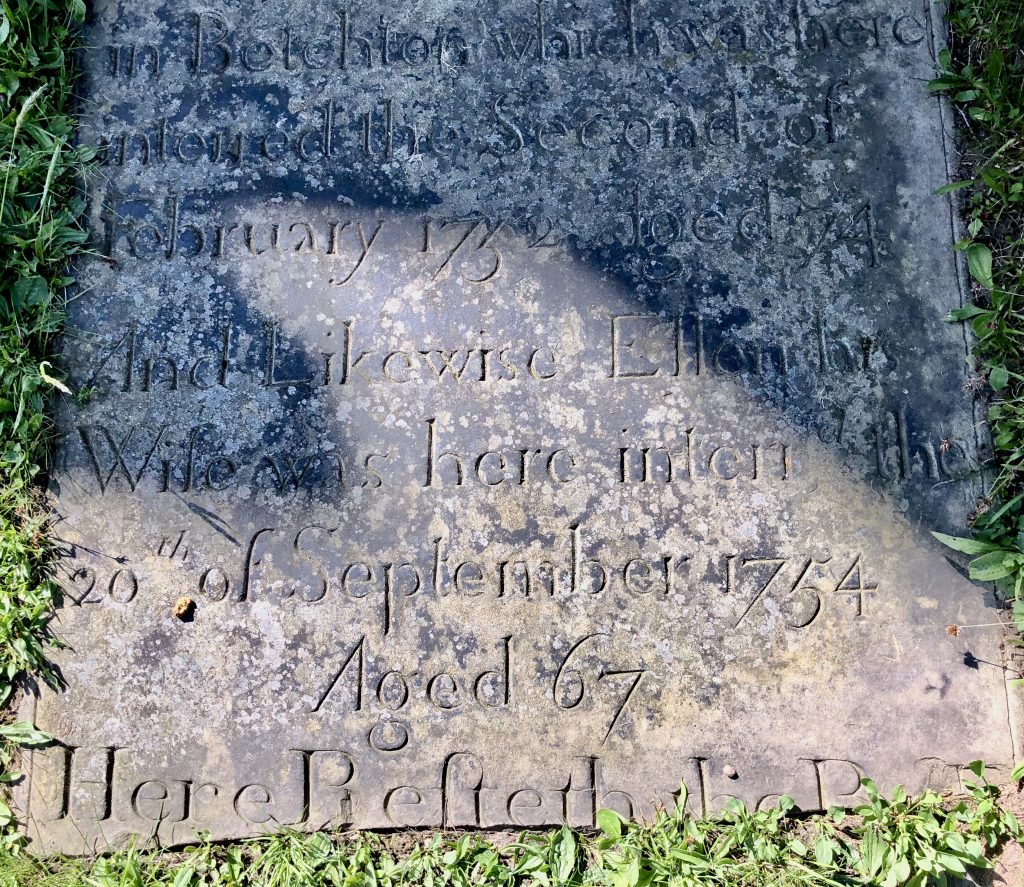
And Likewise Ellen his wife was here interred 20th of September 1754 aged 67.
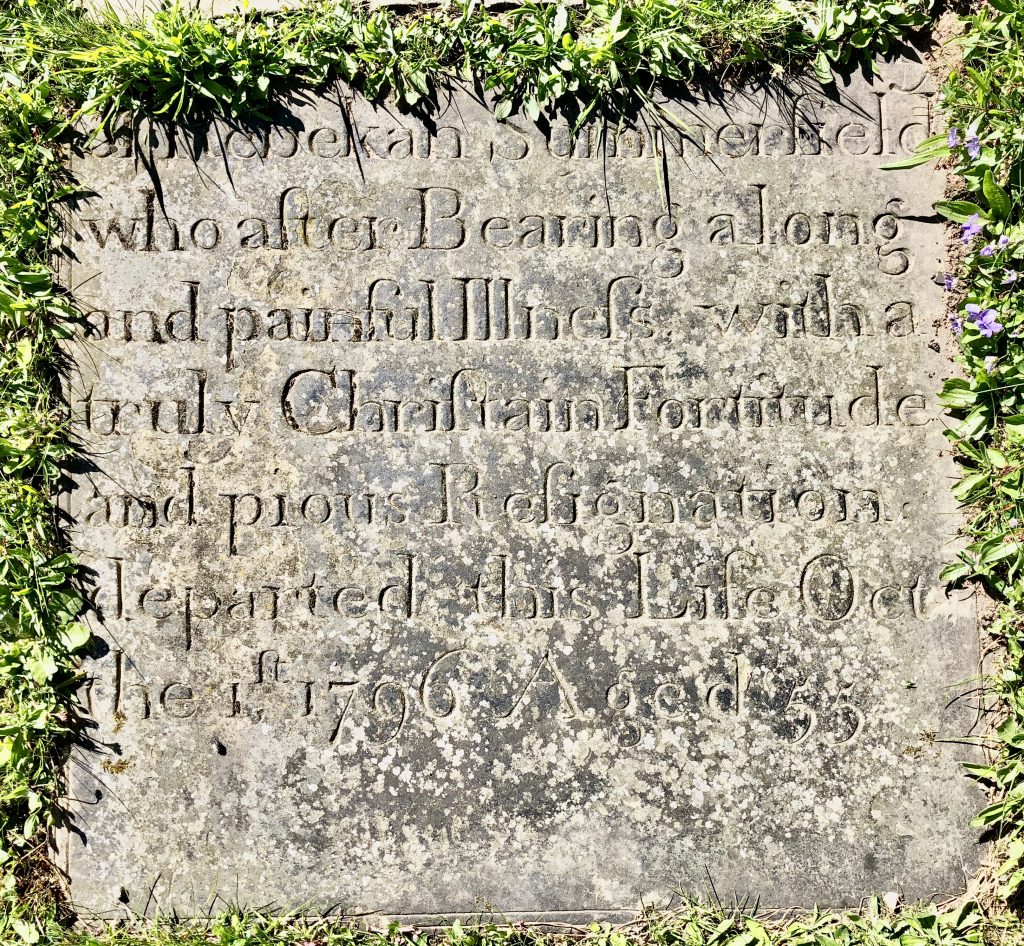
Here resteth the Body of Rebekha Summerfield who after Bearing a long and painful illness with a truly Christian Fortitude and pious Resignation departed this Life October 1st 1796. Aged 55.
Johannes’s other brother, Thomas, was born 1683 and I think is probably the one mentioned on another gravestone in the Sandbach churchyard that also features his nephew Thomas b 1708, son of his brother Johannes, and the wife of Thomas, Rebekha, parents of the Rebekha who had outlived them. There is no burial date for the first Thomas mentioned just his age at death 85 which would mean his death was in 1768. This timeline fits because the first engraving would have been 1768 followed by Rebekha in 1771 and Thomas in 1791. Unfortunately I know no more of Thomas, he obviously lived a long life, but as to wife or children I have found no information. Similarly with the last sibling Maria, born 1685, I have unearthed no information on death, marriage or children.
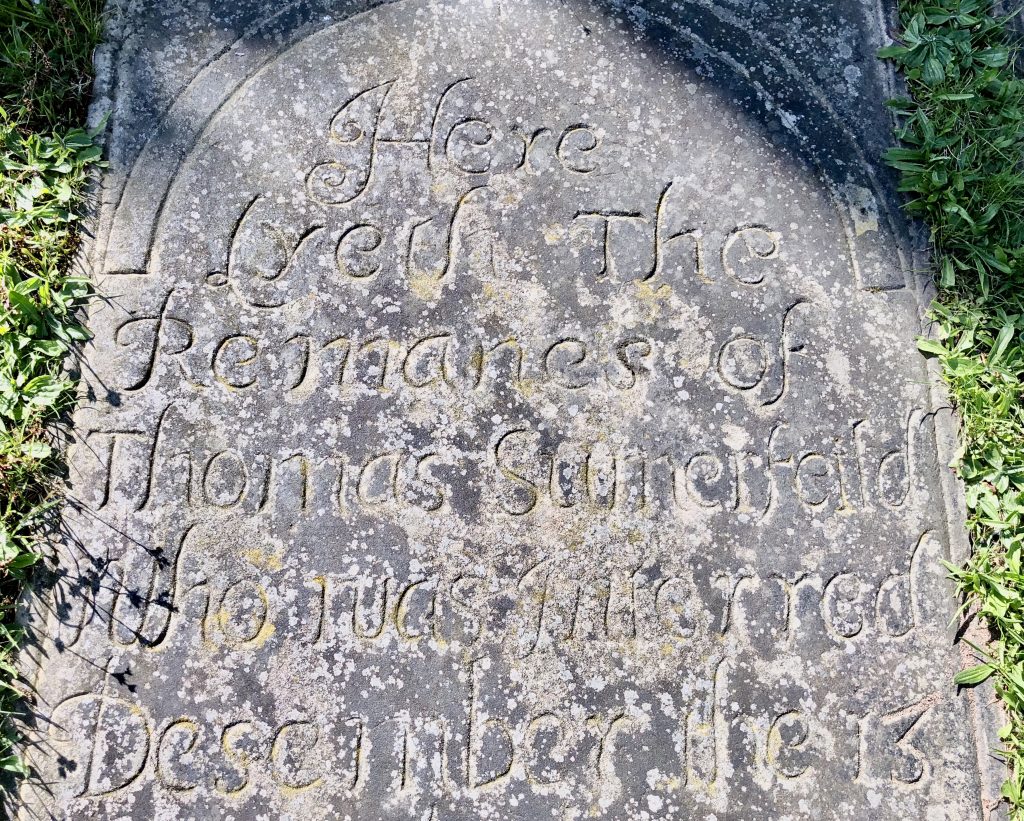
Here Lyeth The Remanes of Thomas Sumerfield Who was Interred Desember the 13 Aged 85
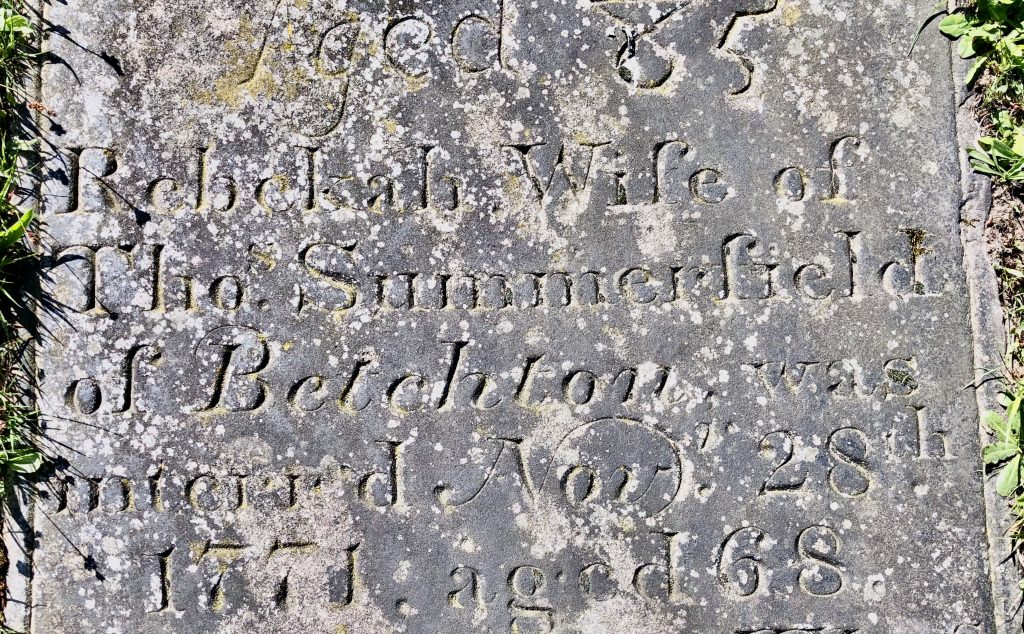
Rebekha Wife of Tho. Summerfield of Betchton was interred Nov. 28th 1771. Aged 68.
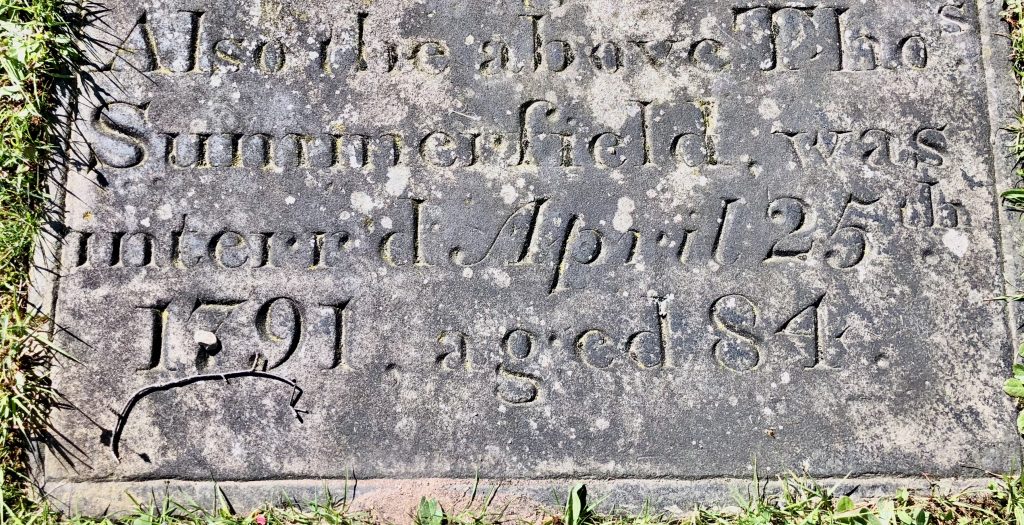
Also above Tho. Summerfield was interred April 25th 1791 aged 84.
My 7th Great Grandfather
Ranulphus Somerfield born 22 April 1681 in Sandbach.
So we now move across from Johannes and Ellen at Crosse farm to continue the journey through my ancestral line with Ranulphus. But I will come back a little later to share some of the information I uncovered with the families living at Crosse Farm. Ranulphus
My 6th Great Grandfather
My 5th Great Grandfather
John Somerfield born 10th May 1702 in Brereton cum Smethwick
My 4th Great Grandfather
Peter Somerfield born 11th October 1727 in Alsager
My
